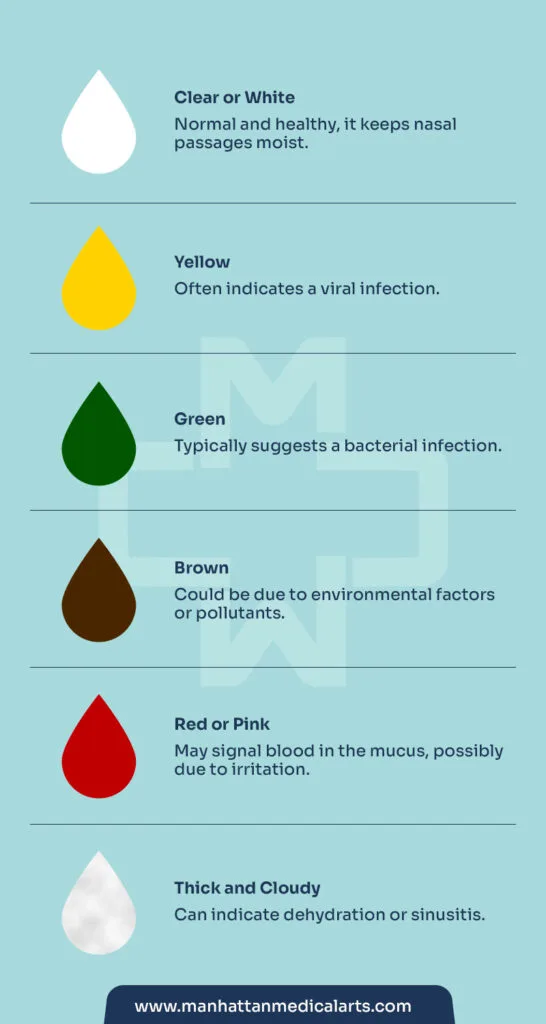We often pay attention to our bodies when something feels off, whether it’s a persistent cough, a headache, or just fatigue. However, have you ever considered the subtle signals that your body might be sending through the color of your nasal mucus?
That’s right – the color of your snot can be a telling indicator of your overall health. In this blog post by Manhattan Medical Arts, we will dive into the world of nasal mucus colors and what they might reveal about your well-being.
Understanding the Role of Nasal Mucus
Before we get into the meanings of different colors, it’s important to understand the role of nasal mucus in our bodies.
Mucus, often referred to informally as “snot,” is a protective substance that is produced by the body’s mucous membranes. It serves our bodies as a natural defense mechanism against germs, allergens, and irritants – and it does so, by trapping them before they can enter your body.

The Color Spectrum: What It Might Indicate
Clear or White Mucus
White or clear mucus is usually a sign of a healthy respiratory system. Clear snot or white snot indicates that your body is doing its job by keeping your nasal tissues moist and free of germs. You might have allergies if you have a lot of clear mucus or white mucus, a runny nose, sneezing, itchy eyes, or mucus dripping down your throat.
However, inflamed tissues in your nose cause the flow of mucus to slow down and lose moisture, which makes it look thick and cloudy in color.
Yellow Mucus
Yellow mucus often suggests the presence of white blood cells, which are the body’s natural defense against sinus infection. Yellow phlegm can indicate that your body is fighting off a viral infection – However, yellow mucus can also be a sign of dehydration, especially if it’s accompanied by a thick consistency.
Green Mucus
Green mucus is often associated with bacterial infections. The green snot coloration results from enzymes produced by dead white blood cells as they combat the sinus infection. If your mucus remains green for more than a week, it might be a sign that you need medical attention to address a potential bacterial infection.
Brown Mucus
Brown mucus can be caused by environmental factors, such as exposure to pollutants or smoke. It might also occur when dried blood mixes with mucus, potentially indicating a small amount of bleeding in the nasal passages. Brown snot may be the result of old blood exiting the body.
Pink or Red Mucus
Seeing red or pink streaks in your mucus might be a sign of blood. Your nasal tissue in the nose has somehow become broken. While this might cause alarm, it’s mostly due to minor irritation, such as frequent nose blowing. If the bleeding is persistent or excessive, consulting a medical professional is recommended.
Black Mucus
Black snot is a dark-colored nasal discharge often caused by inhaling pollutants, smoke, or dust. Black snot may also indicate a chronic respiratory condition or an underlying fungal infection.
Factors That Influence Mucus Color
The color of your nasal mucus can change due to various factors related to your body’s immune response, environment, and overall health.
Here are some reasons why snot changes colors:
Immune Response
When your body detects a sinus infection, whether it’s viral or bacterial, your immune system sends white blood cells to combat the invading pathogens. These white blood cells release enzymes to break down and destroy the invaders. The enzymes, along with the debris from the pathogens and your body’s own cells, can lead to a change in the color of your mucus. This color change is often a sign that your immune system is actively fighting off the infection.
Inflammation:
Infections and irritants can cause inflammation in your nasal passages. Inflammatory cells can release chemicals that alter the color of your mucus. This is why you might notice a color shift when your nose is congested or when you have allergies.
Environmental Factors
Pollutants, smoke, and other environmental irritants can also affect the color of your mucus. When you’re exposed to these factors, your body might produce more thick mucus to trap and eliminate the irritants, leading to changes in color. If your child has a lot of clear nasal discharge, then it could be due to allergies or an environmental trigger.
Dehydration
When you’re dehydrated, your mucus can become thicker and more concentrated. This can sometimes cause a change in color, usually toward a darker shade, as the mucus becomes more concentrated with the substances it contains.
Blood
Minor bleeding in the nasal passages can mix with your mucus and give it a reddish or pinkish hue. This might happen due to dry air, blowing your nose forcefully, or irritation from allergies.
Medications
Some medications, particularly certain nasal sprays or medications that affect blood flow, can impact the blood vessels in your nasal passages and potentially affect the color of your mucus.
Chronic Conditions
Chronic conditions like chronic sinusitis or allergies can cause long-term changes in the color and consistency of your mucus. These conditions might lead to persistent inflammation and ongoing production of discolored or black snot.
NOTE: It’s important to note that while the color of your nasal mucus can provide some clues about your health, it’s just one piece of the puzzle. Other factors such as your overall symptoms, duration of symptoms, and overall health condition should also be considered when making health-related decisions.
When to Seek Medical Attention
While mucus color can provide an insight into your health, it’s important to consider other symptoms as well. If you experience persistent changes in mucus color accompanied by hay fever, pain, sore throat, severe nasal congestion, runny nose, or difficulty breathing, it’s advisable to consult a healthcare provider, such as the expert physicians at Manhattan Medical Arts – so that we can provide an accurate diagnosis and recommend appropriate treatment plan in a timely manner.
Conclusion
In the colorful world of health indicators, your nasal mucus might not be something you’d typically pay much attention to. Yet, as we’ve just explored, it can offer valuable insights into your body’s condition. Whether it’s a clear indication of wellness or a subtle sign of an underlying issue, your snot color can provide a glimpse into your overall health.
Remember, while understanding these signals can be helpful, it’s crucial to rely on the expertise of medical professionals for accurate assessments and diagnoses. If you’re ever uncertain about the significance of your nasal mucus color or experience any concerning symptoms, our dedicated team at Manhattan Medical Arts is here to help.
At Manhattan Medical Arts, we specialize in providing comprehensive and personalized healthcare solutions. Our experienced team of physicians and medical professionals is committed to your well-being, from preventative care to addressing specific health concerns.
We understand that your health journey is unique, and we’re dedicated to being your partners in achieving optimal health!
Frequently Asked Questions
What color is unhealthy snot?
Unhealthy snot can be yellow, green, or brown, indicating infection or irritation.
Is yellow snot bacterial or fungal infection?
Yellow snot often suggests a bacterial infection, but it can also be from other causes like a cold or runny nose.
Does yellow or green snot mean getting better?
Yellow or green snot can mean recovery, as your immune system clears out infection.
Why do I have a white snot?
White or clear mucus usually means dry nasal passages or a mild nasal infection.
How do white blood cells contribute to the color of snot during an infection?
White blood cells, like neutrophils, release enzymes and dead cells into mucus, turning snot yellow or green. Their presence helps fight infection but also changes snot's color.
How many types of fungal infections of the sinuses?
There are several types of fungal sinus infections: allergic fungal sinusitis, invasive fungal sinusitis, chronic granulomatous sinusitis, and fungal ball sinusitis.
How can I get rid of black mucus?
To get rid of black mucus, stay hydrated, use a humidifier, and use a saline nasal spray. Avoid irritants like smoke. If it persists, see a doctor to check for infections or other issues.
– Disclaimer –
This blog is for informational & educational purposes only, and does not intend to substitute any professional medical advice or consultation. For any health related concerns, please consult with your physician, or call 911.
-
About The Author
Dr. Syra Hanif M.D.Board Certified Primary Care Physician
Dr. Syra Hanif is a board-certified Primary Care Physician (PCP) dedicated to providing compassionate, patient-centered healthcare.
Read More







